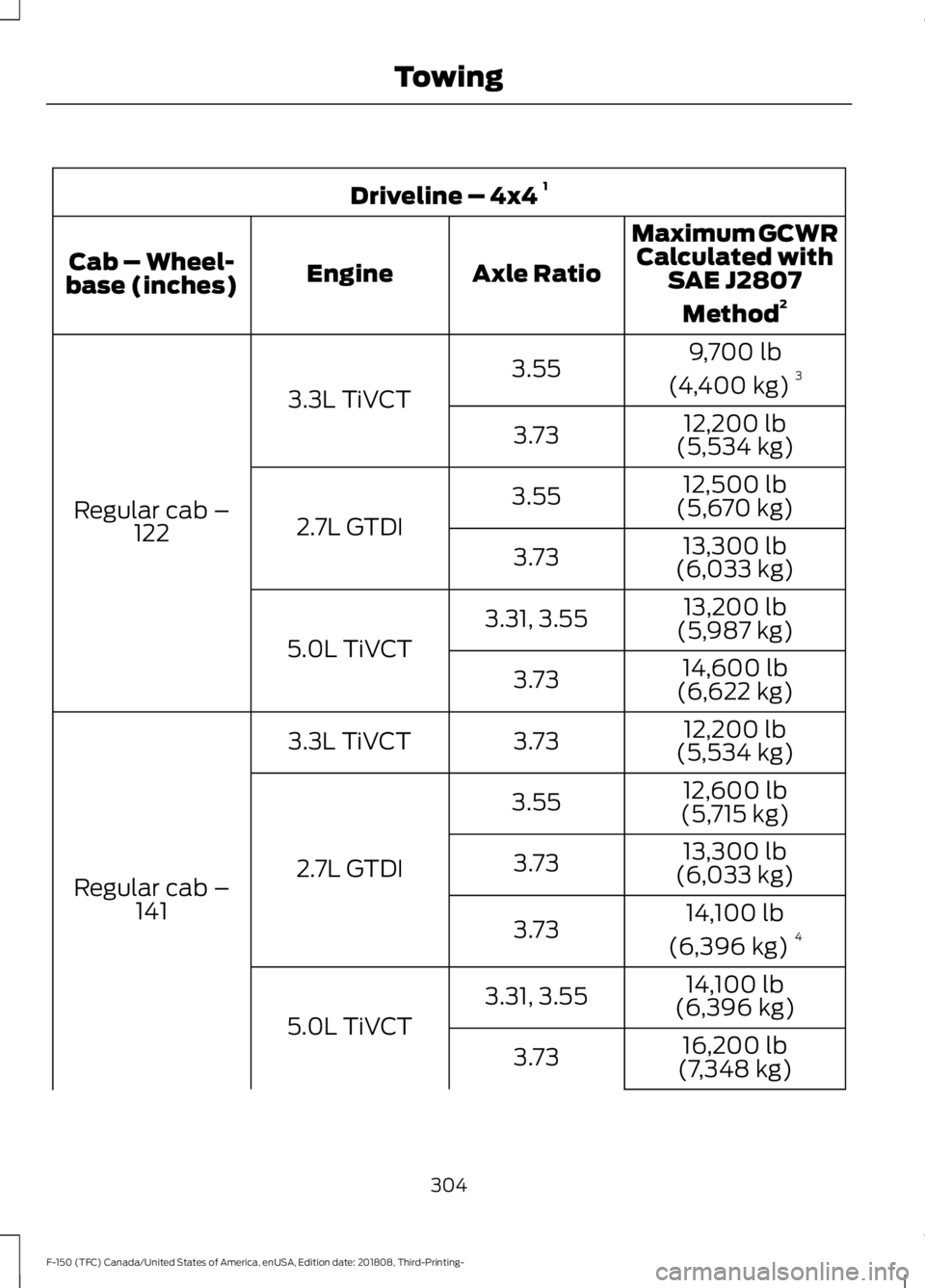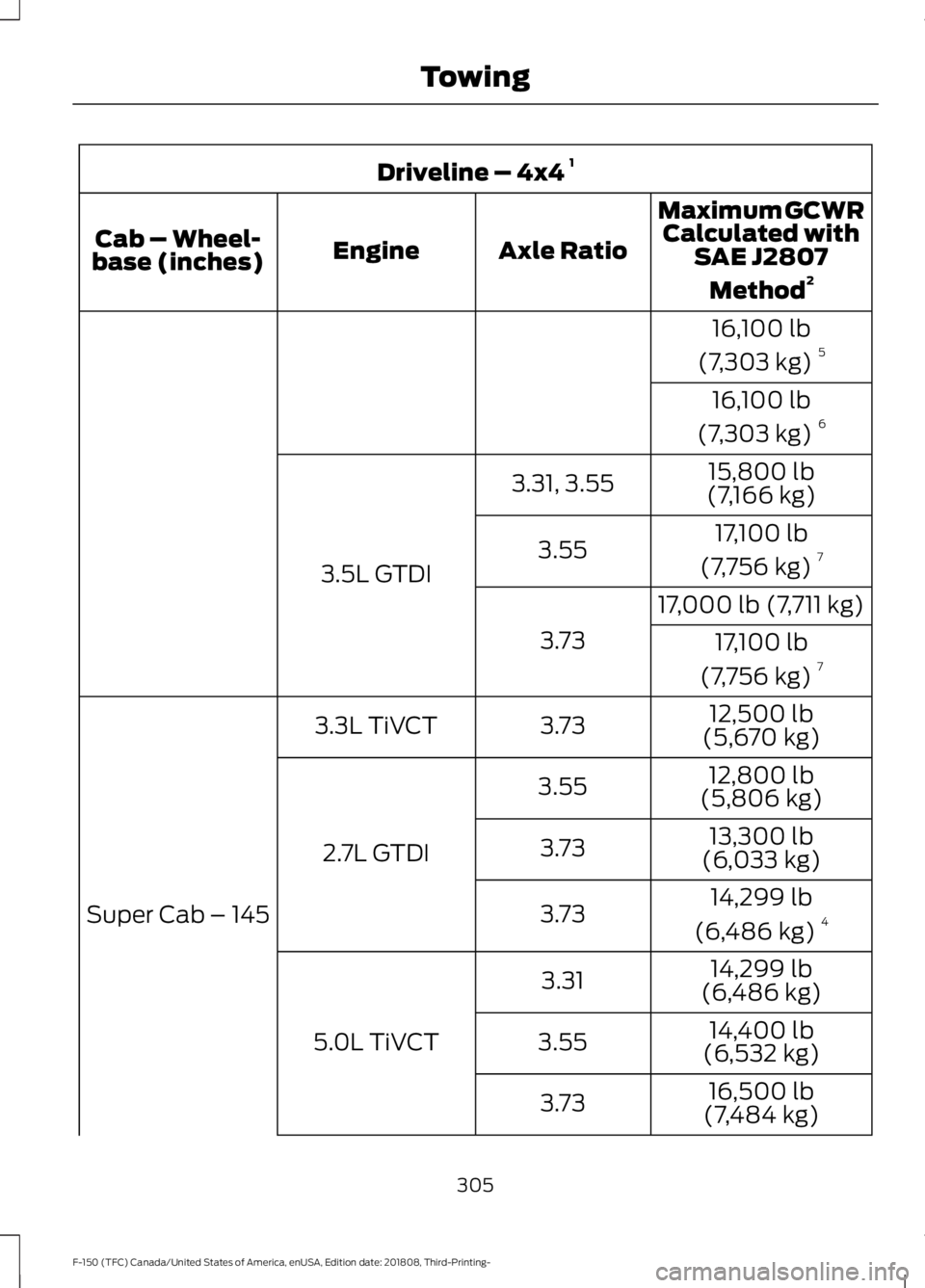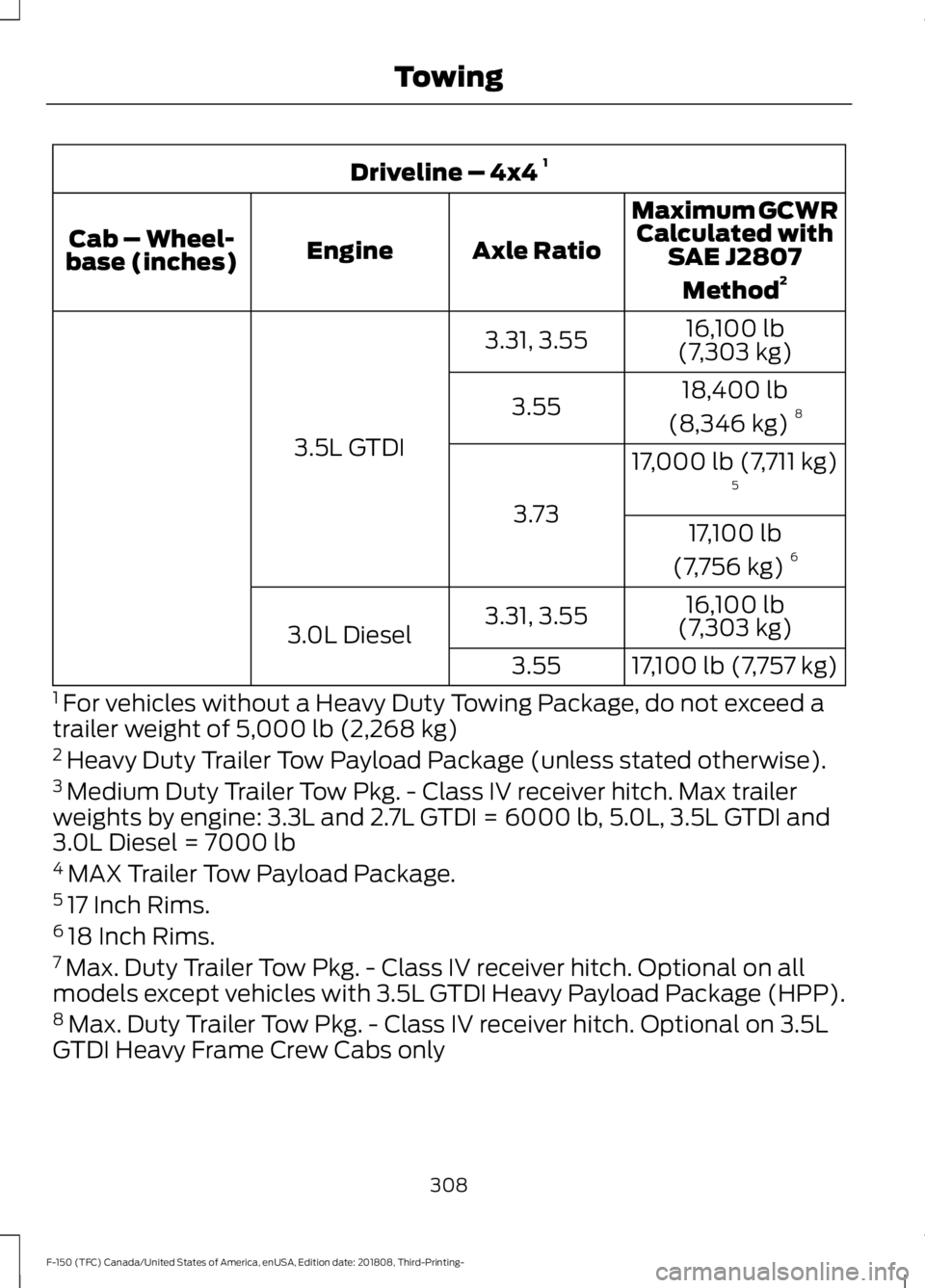2019 FORD F-150 engine
[x] Cancel search: enginePage 307 of 644

Driveline – 4x4
1
Maximum GCWRCalculated with SAE J2807
Method 2
Axle Ratio
Engine
Cab – Wheel-
base (inches)
9,700 lb
(4,400 kg) 3
3.55
3.3L TiVCT
Regular cab – 122 12,200 lb
(5,534 kg)
3.73
12,500 lb
(5,670 kg)
3.55
2.7L GTDI 13,300 lb
(6,033 kg)
3.73
13,200 lb
(5,987 kg)
3.31, 3.55
5.0L TiVCT 14,600 lb
(6,622 kg)
3.73
12,200 lb
(5,534 kg)
3.73
3.3L TiVCT
Regular cab – 141 12,600 lb
(5,715 kg)
3.55
2.7L GTDI 13,300 lb
(6,033 kg)
3.73
14,100 lb
(6,396 kg) 4
3.73
14,100 lb
(6,396 kg)
3.31, 3.55
5.0L TiVCT 16,200 lb
(7,348 kg)
3.73
304
F-150 (TFC) Canada/United States of America, enUSA, Edition date: 201808, Third-Printing- Towing
Page 308 of 644

Driveline – 4x4
1
Maximum GCWRCalculated with SAE J2807
Method 2
Axle Ratio
Engine
Cab – Wheel-
base (inches)
16,100 lb
(7,303 kg) 5
16,100 lb
(7,303 kg) 6
15,800 lb
(7,166 kg)
3.31, 3.55
3.5L GTDI 17,100 lb
(7,756 kg) 7
3.55
17,000 lb (7,711 kg)
3.73 17,100 lb
(7,756 kg) 7
12,500 lb
(5,670 kg)
3.73
3.3L TiVCT
Super Cab – 145 12,800 lb
(5,806 kg)
3.55
2.7L GTDI 13,300 lb
(6,033 kg)
3.73
14,299 lb
(6,486 kg) 4
3.73
14,299 lb
(6,486 kg)
3.31
5.0L TiVCT 14,400 lb
(6,532 kg)
3.55
16,500 lb
(7,484 kg)
3.73
305
F-150 (TFC) Canada/United States of America, enUSA, Edition date: 201808, Third-Printing- Towing
Page 309 of 644

Driveline – 4x4
1
Maximum GCWRCalculated with SAE J2807
Method 2
Axle Ratio
Engine
Cab – Wheel-
base (inches)
16,000 lb
(7,257 kg)
3.31, 3.55
3.5L GTDI 17,100 lb
(7,756 kg) 7
3.55
14,400 lb
(6,532 kg)
3.31
5.0L TiVCT
Super Cab – 163 14,500 lb
(6,577 kg)
3.55
16,200 lb
(7,348 kg)
3.73
16,200 lb
(7,348 kg)
3.31, 3.55
3.5L GTDI 17,100 lb (7,757 kg)
7
3.55
17,100 lb (7,757 kg)7
3.73
12,600 lb
(5,715 kg)
3.73
3.3L TiVCT
Crew cab – 145 12,900 lb
(5,851 kg)
3.55
2.7L GTDI 13,300 lb
(6,033 kg)
3.73
14,300 lb
(6,486 kg) 4
3.73
306
F-150 (TFC) Canada/United States of America, enUSA, Edition date: 201808, Third-Printing- Towing
Page 310 of 644

Driveline – 4x4
1
Maximum GCWRCalculated with SAE J2807
Method 2
Axle Ratio
Engine
Cab – Wheel-
base (inches)
14,300 lb
(6,486 kg)
3.31
5.0L TiVCT 14,400 lb
(6,532 kg)
3.55
16,200 lb
(7,348 kg)
3.73
16,100 lb
(7,303 kg)
3.31, 3.55
3.5L GTDI 18,100 lb
(8,210 kg) 8
3.55
16,100 lb
(7,303 kg)
3.31
3.5L 10.5:1 CR 16,700 lb
(7,575 kg)
3.55
16,000 lb
(7,257 kg)
3.31, 3.55
3.0L Diesel 17,100 lb
(7,756 kg)
3.55
14,400 lb
(6,532 kg)
3.31
5.0L TiVCT
Crew cab – 157 14,500 lb
(6,577 kg)
3.55
16,900 lb
(7,666 kg)
3.73
16,200 lb
(7,348 kg)
3.73
307
F-150 (TFC) Canada/United States of America, enUSA, Edition date: 201808, Third-Printing- Towing
Page 311 of 644

Driveline – 4x4
1
Maximum GCWRCalculated with SAE J2807
Method 2
Axle Ratio
Engine
Cab – Wheel-
base (inches)
16,100 lb
(7,303 kg)
3.31, 3.55
3.5L GTDI 18,400 lb
(8,346 kg) 8
3.55
17,000 lb (7,711 kg)5
3.73 17,100 lb
(7,756 kg) 6
16,100 lb
(7,303 kg)
3.31, 3.55
3.0L Diesel
17,100 lb (7,757 kg)
3.55
1 For vehicles without a Heavy Duty Towing Package, do not exceed a
trailer weight of 5,000 lb (2,268 kg)
2 Heavy Duty Trailer Tow Payload Package (unless stated otherwise).
3 Medium Duty Trailer Tow Pkg. - Class IV receiver hitch. Max trailer
weights by engine: 3.3L and 2.7L GTDI = 6000 lb, 5.0L, 3.5L GTDI and
3.0L Diesel = 7000 lb
4 MAX Trailer Tow Payload Package.
5 17 Inch Rims.
6 18 Inch Rims.
7 Max. Duty Trailer Tow Pkg. - Class IV receiver hitch. Optional on all
models except vehicles with 3.5L GTDI Heavy Payload Package (HPP).
8 Max. Duty Trailer Tow Pkg. - Class IV receiver hitch. Optional on 3.5L
GTDI Heavy Frame Crew Cabs only
308
F-150 (TFC) Canada/United States of America, enUSA, Edition date: 201808, Third-Printing- Towing
Page 317 of 644

Points to Remember
Note:
Do not attempt removal of the trailer
brake controller without consulting the
Workshop Manual. Damage to the unit may
result.
• Adjust gain setting before using the
trailer brake controller for the first time.
• Adjust gain setting, using the procedure
above, whenever road, weather and
trailer or vehicle loading conditions
change from when the gain was initially
set.
• Only use the manual control lever for
proper adjustment of the gain during
trailer setup. Misuse, such as
application during trailer sway, could
cause instability of trailer or tow
vehicle.
• Avoid towing in adverse weather
conditions. The trailer brake controller
does not provide anti-lock control of
the trailer wheels. Trailer wheels can
lock up on slippery surfaces, resulting
in reduced stability of trailer and tow
vehicle.
• The trailer brake controller is equipped
with a feature that reduces output at
vehicle speeds below 11 mph (18 km/h)
so trailer and vehicle braking is not jerky
or harsh. This feature is only available
when applying the brakes using your
vehicle's brake pedal, not the
controller.
• The controller interacts with the brake
control system and powertrain control
system of your vehicle to provide the
best performance on different road
conditions.
• Your vehicle's brake system and the
trailer brake system work
independently of each other. Changing
the gain setting on the controller does
not affect the operation of your
vehicle's brakes whether you attach a
trailer or not. •
When you switch the engine off, the
controller output is disabled and the
display and module shut down. The
controller module and display turn on
when you switch the ignition on.
• The trailer brake controller is only a
factory-installed or dealer-installed
item. Ford is not responsible for
warranty or performance of the
controller due to misuse or customer
installation.
Trailer Lamps WARNING: Never connect any
trailer lamp wiring to the vehicle's tail
lamp wiring; this may damage the
electrical system resulting in fire. Contact
your authorized dealer as soon as
possible for assistance in proper trailer
tow wiring installation. Additional
electrical equipment may be required.
Trailer lamps are required on most towed
vehicles. Make sure all running lights, brake
lights, turn signals and hazard lights are
working.
Using a Step Bumper
(If Equipped)
The rear bumper is equipped with an
integral hitch and only requires a ball with
a one-inch (25.4 millimeter) shank
diameter. The bumper has a
5,000 lb
(2,268 kg) trailer weight and a 500 lb
(227 kg) tongue weight capacity.
If it is necessary to relocate the hitch ball
position, you must install a frame-mounted
trailer hitch.
314
F-150 (TFC) Canada/United States of America, enUSA, Edition date: 201808, Third-Printing- Towing
Page 318 of 644

Before Towing a Trailer
Practice turning, stopping and backing up
to get the feel of your vehicle-trailer
combination before starting on a trip.
When turning, make wider turns so the
trailer wheels clear curbs and other
obstacles.
When Towing a Trailer
•
Do not drive faster than 70 mph
(113 km/h) during the first 500 mi
(800 km).
• Do not make full-throttle starts.
• Check your hitch, electrical connections
and trailer wheel lug nuts thoroughly
after you have traveled 50 mi (80 km).
• When stopped in congested or heavy
traffic during hot weather, place the
transmission in park (P) to aid engine
and transmission cooling and to help
A/C performance.
• Turn off the speed control with heavy
loads or in hilly terrain. The speed
control may turn off automatically
when you are towing on long, steep
grades.
• Shift to a lower gear when driving down
a long or steep hill. Do not apply the
brakes continuously, as they may
overheat and become less effective.
• If your transmission is equipped with a
Grade Assist or Tow/Haul feature, use
this feature when towing. This provides
engine braking and helps eliminate
excessive transmission shifting for
optimum fuel economy and
transmission cooling.
• If your vehicle is equipped with
AdvanceTrac with RSC, this system
may turn on during typical cornering
maneuvers with a heavily loaded trailer.
This is normal. Turning the corner at a
slower speed while towing may reduce
this tendency. •
If you are towing a trailer frequently in
hot weather, hilly conditions, at the
gross combined weight rating (or any
combination of these factors), consider
refilling your rear axle with synthetic
gear lubricant (if the axle is not already
filled with it). See
Capacities and
Specifications (page 419).
• Allow more distance for stopping with
a trailer attached. Anticipate stops and
brake gradually.
• Avoid parking on a grade. However, if
you must park on a grade:
1. Turn the steering wheel to point your vehicle tires away from traffic flow.
2. Set your vehicle parking brake.
3. Place the automatic transmission in park (P).
4. Place wheel chocks in front and back of the trailer wheels. Chocks are not
included with your vehicle.
Your vehicle may be equipped with a
temporary or conventional spare tire. A
temporary spare tire is different in diameter
or width, tread-type, or is from a different
manufacturer than the road tires on your
vehicle. Consult information on the tire
label or Safety Compliance label for
limitations when using.
Launching or Retrieving a Boat or
Personal Watercraft (PWC)
Note: Disconnect the wiring to the trailer
before
backing the trailer into the water.
Note: Reconnect the wiring to the trailer
after
removing the trailer from the water.
315
F-150 (TFC) Canada/United States of America, enUSA, Edition date: 201808, Third-Printing- Towing
Page 320 of 644

Four-wheel Drive Vehicles
You can only tow a four-wheel drive
vehicle with all wheels on the ground by
placing the transfer case in its neutral
position and engaging the
four-wheel-down towing feature. Perform
the steps outlined in the following section
after positioning your vehicle behind the
tow vehicle and properly securing them
together.
Note:
Make sure you properly secure your
vehicle to the tow vehicle.
Note: For F-150 Raptor, please refer to your
Raptor supplement guide.
Four-wheel-down Towing
1. Put the ignition in the on position, but do not start the engine. If your vehicle
has an ignition key, turn the key to on.
If your vehicle has intelligent access,
press the engine START/STOP button
once without pressing the brake pedal.
2. Press and hold the brake pedal.
3. Rotate the four-wheel drive switch to 2H.
4. Shift the transmission to neutral (N).
5. Rotate the four-wheel drive switch from
2H to 4L and back to 2H five
times within seven seconds. If
completed successfully, the
information display shows
NEUTRAL
TOWLEAVE IN N or Neutral Tow
Enabled Leave Transmission in
Neutral
. This indicates that your
vehicle is safe to tow with all wheels
on the ground.
Note: If you do not see the message in the
display, you must perform the procedure
again from the beginning.
Note: You may hear an audible noise as the
transfer case shifts into its neutral position.
This is normal. 6. Leave the transmission in neutral (N)
and turn the ignition as far as it can go
toward the off position. It does not turn
fully off when the transmission is in
neutral (N). If your vehicle has an
ignition key, you must leave the key in
the ignition while towing. To lock and
unlock your vehicle, use the keyless
entry keypad or an extra set of keys. If
your vehicle has intelligent access,
press the engine START/STOP button
once without pressing the brake pedal.
You do not need to leave your keys in
the vehicle. You can lock and unlock
your vehicle as you normally do.
7. Release the brake pedal. WARNING:
Do not disconnect the
battery during recreational towing. It
prevents the transfer case from shifting
properly and may cause the vehicle to
roll, even if the transmission is in park
(P). WARNING:
Shifting the transfer
case to its neutral position for
recreational towing may cause the
vehicle to roll, even if the transmission is
in park (P). It may injure the driver and
others. Make sure you press the foot
brake and the vehicle is in a secure, safe
position when you shift to neutral (N).
Note: Failing to put the transfer case in its
neutral position while towing the vehicle
can damage vehicle components.
Note: You can check four-wheel-down
towing status at any time by opening the
driver's door or turning the ignition to the
accessory or on position. A message
displays in the information display
confirming your vehicle is in neutral tow.
To exit four-wheel-down towing and return
the transfer case to its
2H position:
317
F-150 (TFC) Canada/United States of America, enUSA, Edition date: 201808, Third-Printing- Towing